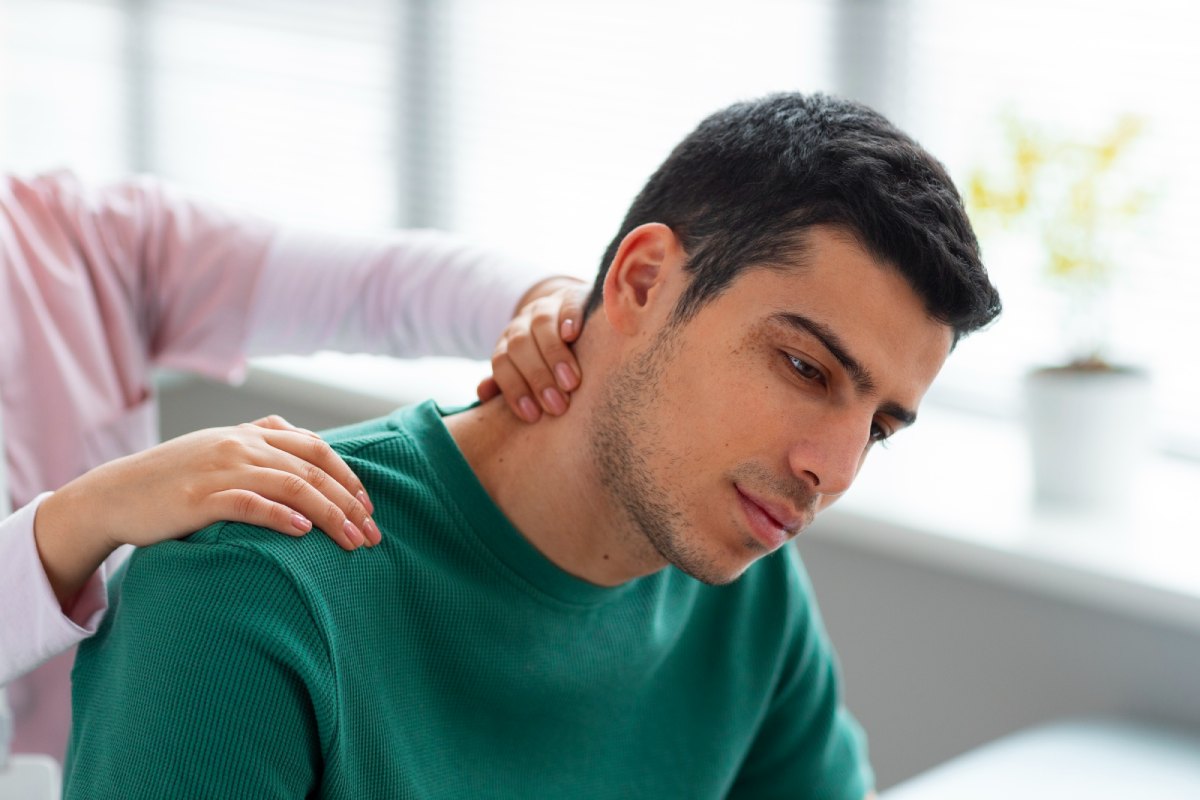Fibromyalgia is a long-term condition that causes widespread pain and tenderness throughout the body. It’s often described as a deep, persistent ache that affects the muscles, tendons, and joints. Many people with fibromyalgia also experience fatigue, poor sleep, and sensitivity to touch or temperature.
This chronic disorder doesn’t damage joints or muscles permanently, but it affects how the brain and nervous system process pain signals, making even mild sensations feel more intense.
Common Symptoms and How They Affect Daily Life
Fibromyalgia symptoms vary from person to person, but common signs include:
- Persistent pain in muscles and joints
- Fatigue and lack of energy
- Difficulty sleeping or waking up tired
- Headaches and stiffness, especially in the neck and shoulders
- Brain fog or difficulty concentrating
These symptoms can make daily activities—like working, cooking, or even sitting for long hours—quite challenging.
Is Fibromyalgia an Autoimmune Disease? Myths vs. Facts
There’s often confusion around fibromyalgia being an autoimmune disorder. However, fibromyalgia is not an autoimmune disease.
While autoimmune conditions like lupus or rheumatoid arthritis involve the immune system attacking the body’s tissues, fibromyalgia stems from abnormal pain processing in the brain and nerves.
That said, the symptoms can sometimes overlap, which is why an accurate diagnosis is important.
The Connection Between Fibromyalgia and Neck & Shoulder Pain

Why Neck and Shoulder Pain Are So Common in Fibromyalgia
Neck and shoulder pain are among the most frequent complaints in fibromyalgia. The muscles in these areas are constantly under tension due to poor posture, emotional stress, and nerve hypersensitivity. Over time, this tension causes muscle knots and stiffness.
How Muscle Stiffness and Fatigue Intensify Pain
Fibromyalgia patients often have low muscle endurance. When the muscles tire easily, it leads to stiffness and limited mobility. This cycle of pain and fatigue can make even simple movements, like turning the head or lifting an arm, uncomfortable.
Physiotherapy for Fibromyalgia: A Holistic Healing Approach
What Does Physiotherapy for Fibromyalgia Include?
Physiotherapy focuses on improving mobility, reducing pain, and restoring function. In fibromyalgia care, physiotherapists use gentle exercises, posture correction, manual therapy, and relaxation techniques to help patients move comfortably again.
The Science Behind Physiotherapy in Pain Management
Through consistent movement and muscle re-education, physiotherapy helps the brain rewire how it interprets pain. This is known as neuroplasticity—teaching the nervous system to respond calmly to physical activity instead of triggering pain.
Physiotherapy Exercises for Fibromyalgia Neck and Shoulder Pain

Gentle Stretching Techniques to Ease Muscle Tension
Slow, mindful stretching is a key part of physiotherapy for fibromyalgia. Neck rotations, shoulder rolls, and upper-back stretches relieve muscle tightness and improve blood circulation.
Strength-Building and Posture Correction Exercises
Strengthening weak muscles helps reduce strain on sensitive areas. Simple resistance band exercises or isometric neck strengthening can make a big difference. Physiotherapists also guide patients to correct posture—something often overlooked but essential for long-term relief.
Breathing and Relaxation Routines to Reduce Stress
Deep breathing exercises and guided relaxation lower stress hormones and reduce pain flare-ups. Combining these with physical therapy creates a more balanced and healing experience.
Benefits of Physiotherapy for Fibromyalgia Patients
Improved Mobility and Flexibility
Regular physiotherapy sessions increase joint range of motion and make daily activities easier.
Reduced Pain Sensitivity and Muscle Tenderness
Physiotherapy helps desensitize overactive pain receptors, gradually reducing muscle soreness and fatigue.
Enhanced Sleep Quality and Emotional Well-being
By relaxing tense muscles and lowering stress, physiotherapy contributes to better sleep and mood stability.
Fibromyalgia Physiotherapy in Kolkata: The Shape and Strength Approach
Personalized Care for Chronic Pain Management
At Shape and Strength, physiotherapy for fibromyalgia is never one-size-fits-all. Each patient receives a tailored plan based on their pain patterns, triggers, and lifestyle.
Techniques Used at Shape and Strength
Therapists combine manual therapy, stretching routines, and guided exercises with patient education to ensure sustainable results. Sessions are designed to be gentle yet effective, focusing on gradual improvement rather than quick fixes.
Building Long-Term Strength and Stability
With consistent physiotherapy, patients notice better posture, reduced stiffness, and improved overall quality of life. The goal at Shape and Strength is to help individuals regain confidence in movement without fear of pain.
Frequently Asked Questions (FAQs)
What type of physiotherapy is best for fibromyalgia?
Gentle stretching, low-impact aerobic training, and relaxation-based therapy are most effective.
Can physiotherapy completely cure fibromyalgia?
Fibromyalgia can’t be “cured,” but physiotherapy helps manage symptoms and improve quality of life significantly.
How often should I do physiotherapy exercises?
Consistency is key—most patients benefit from 2–3 sessions per week, as advised by their physiotherapist.
Is physiotherapy safe for chronic pain conditions?
Yes, when done under professional supervision, it’s completely safe and beneficial.
Does weather affect fibromyalgia pain?
Yes, cold or humid weather can increase stiffness and pain sensitivity in some patients.
How long does it take to see improvement?
Most people notice gradual improvement in pain and flexibility within 4–6 weeks of regular physiotherapy.
Conclusion
Fibromyalgia may be a lifelong condition, but with the right care, its symptoms can be managed effectively. Physiotherapy for Fibromyalgia, especially when guided by experts like those at Shape and Strength in Kolkata, provides not just pain relief but also a path toward renewed strength, flexibility, and confidence in movement.






